|
|
Inspired and dedicated as per personal communication with Rocco Prock, November 15, 2010
Updated as per James P. Tuttle's The Hawk Moths of North America, November 15, 2010
Updated as per Butterflies and Moths of North America, formerly USGS, November 15, 2010
|
Clark County, Nevada
Sphingidae Larvae
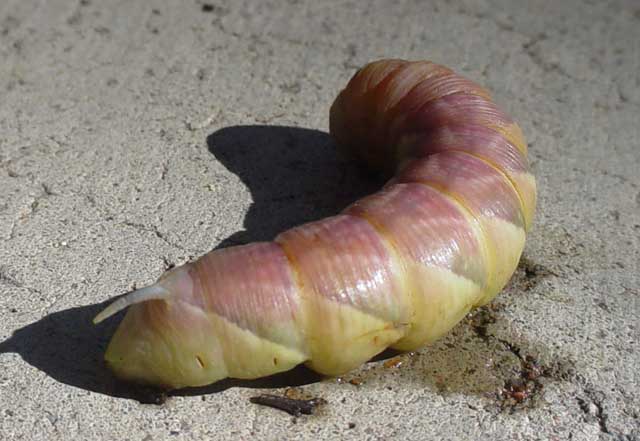
Sphinx chersis, fifth instar, Las Vegas, Clark Co., Nevada,
November 14, 2010, courtesy of Rocco Prock.
This site has been created by
Bill Oehlke at oehlkew@islandtelecom.com
Comments, suggestions and/or additional information/sightings are welcomed by Bill.
For care of "found larvae/caterpillars" visit Manduca sexta larva, central Texas, August 21, 2008, Trina Woodall.
This page is inspired by and dedicated to
Rocco Prock. Rocco sent me the beautiful
images of the Sphinx chersis larva at the top and bottom of this page.
Rocco writes, November 15, 2010, "We found this in the alley and brought him/her into our back yard.
"The days are comfortable here, between 70 and 80 during the day. The nights are between 43 and 59. It was 59 this morning at 5:30 when I left for work.
"We put the sphinx in a mid-sized fish tank with 4 inches of soil in it after reading your information. We do not know if the soil is the correct type.
Our earth does not have any clay in it and is not much like loam.
"We did not want to release him in the back yard because of the large birds and lizards that might eat him.
"The fish tank is in a room at around 75 degrees. We want him to be safe and mature into the moth. Do you have any suggestions? Food, Air, Temperature,
soil, ect."
I replied, "Rocco,
"The Sphinx larva is Sphinx chersis, the Great Ash Sphinx.
"Pretty much any local soil type is okay so long as it is soft enough for excavation by the larvae. It is also possible to get the larva top pupate
without the soil, as per the article, linked below about care of found larva. I recommend you give it about a week to pupate and then very carefully
excavate it and treat as per the article. Best of luck.
Thanks for sharing photos.
Just qa few days ago this caterpillar would have been much more green. Many of the Sphingidae larvae take on a reddish hue, just prior to pupation,
especially if they are going to overwinter."
For care of "found larvae/caterpillars" visit Manduca sexta larva, central Texas, August 21, 2008, Trina Woodall.
Eighteen Sphingidae species are listed for Nevada on the U.S.G.S.
website. Some of them would be adult strays into Nevada. Not all of the species are reported or anticipated in
Clark County (thirteen are reported on U.S.G.S., with
Sphinx perelegans, Sphinx sequoiae AND Erinnyis ello probably only present as adult strays). It is hoped
that this checklist, with the thumbnails and notes, will help you
quickly identify the caterpillars you are likely to encounter.
A "WO" after the species name indicates that
I (William Oehlke) expect that this larva is present or
might be present, although unreported.
A "USGS" indicates the species is confirmed
on USGS site.
Please help me develop this list with improved, documented accuracy
by sending sightings (species, date, location), preferably with an
electronic image, via email to
Bill Oehlke.
Sphinginae subfamily
Sphingini tribe:

|
The caterpillars are called Tomato Hornworms and each has a black horn at the end of the abdomen.
Larvae feed on potato, tobacco, tomato, and other plants in the
nightshade family (Solanaceae). Most larvae are green, but there is also a very beautiful brown
form to the left.
|
 |
Tobacco Hornworms, equipped with a red-tipped horn at the end of the
abdomen, are true gluttons and feed on tobacco and tomato, and
occasionally potato and pepper crops and other plants in the
nightshade family (Solanaceae).
|
 |
Larval hosts are Manzanita and Arctostaphylos
of the Ericaceae family. Look for a blue horn and strong purple
colouration.
|
 |
The larvae are pale bluish green. The head has a pair of yellow
lateral bands meeting at the apex.
Larval hosts are ash, lilac, privet, cherry, and quaking aspen.
|
 | Larval hosts are Alligator juniper (Juniperus deppeana)
and other juniper species. It is amazing to me how well the larval
spiracular patches and false feet match
the pattern and colour of the juniper bark.
|
 | Larvae feed on New Mexican forestiera
(Forestiera neomexicana), on Forestiera angustifolia
and on little leaf ash (Fraxinus gooddingii) in the Oleaceae
family. There are green and dark forms and all larvae tend to darken
just before pupation.
|
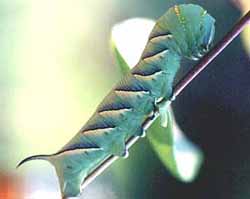 |
Sphinx vashti
USGS,
the Snowberry Sphinx
Larvae feed on the common snowberry (Symphoricarpos albus)
and on coralberry (S. orbiculatus). Note the two golden
lines of slightly raised bumps, one just behind the head, the other
on the thorax.
|
Smerinthini Tribe:
 |
Larvae feed on cottonwood and poplar (Populus) and willow
(Salix).
Larvae are very chunky with little to distinguish them
from Pachysphinx modesta.
|
 |
Paonias myops
WO?,
the Small-eyed Sphinx
Wild cherry species are the favorites as larval
foodplants, but eggs will also be deposited on birches and other
forest trees. To the left a second/third instar larva rests on pin
cherry.
The "red heart" marking readily identifies this species.
generally more eastern species; possibly |
 |
Smerinthus cerisyi
USGS,
Cerisy's Sphinx;
Cerisyi larvae greatly resemble modesta larvae, both being pale
green, with granular skin, pale lateral diagonal lines, faint red
spiracular circles, and very pale longitudinal lines running from the
head to a more pronounced anal diagonal line.
Larvae have green heads bounded dorsally with a pale yellow
inverted "V".
|
Macroglossinae subfamily
Dilophonotini tribe:
 |
Larval host plants include Snowberry (Symphoricarpos),
honeysuckle (Lonicera), Coralberry, viburnums, high bush cranberry and hawthorn (Crataegus).
Horn is black with a slightly lighter base. This western species was formerly classified as
H. diffinis or H. senta. Those species west of the Continental Divide are now classified as
H. thetis.
|
Philampelini tribe:
 |
Larvae feed upon Grape (Vitis), Virginia Creeper
(Parthenocissus quinquefolia) and other vines and ivies
(Ampelopsis).
Larvae occur in both a light (green) form and a darker (tan/brown)
form. Note six "segmented" oblique lines.
|
Macroglossini tribe:
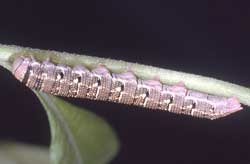 |
Euproserpinus wiesti
WO,
Wiest's Primrose Sphinx.
Euproserpinus wiesti adults fly, during the day, over sand washes
and prairie
blow-outs as a single brood from May-June. Larvae feed on prairie primrose (Oenothera latifolia) in the evening primrose family (Onagraceae).
Trying to rear in captivity has proven difficult. Larvae seem to need sunshine, heat and humidity.
|
 |
Hyles lineata
USGS, the White-lined Sphinx
Larvae are highly varied and feed on a great diversity of plants
including willow weed (Epilobium), four o'clock (Mirabilis),
apple (Malus), evening primrose (Oenothera), elm
(Ulmus), grape (Vitis), tomato (Lycopersicon),
purslane (Portulaca), and Fuschia.
All larvae seem, however, to have the red/black swellings split by
dorso-lateral lines. |
|
|
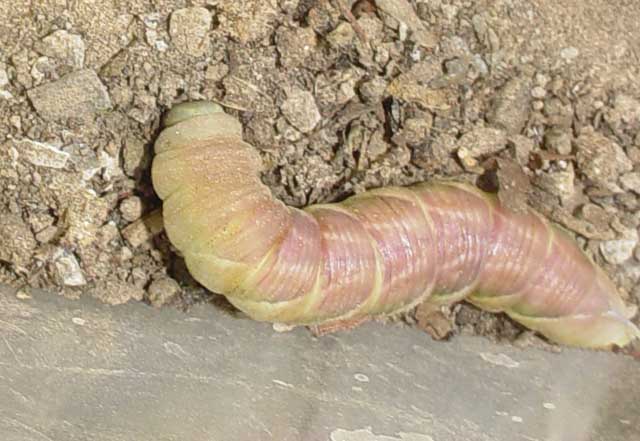
Sphinx chersis, fifth instar, Las Vegas, Clark Co., Nevada,
November 14, 2010, courtesy of Rocco Prock.
Enjoy some of nature's wonderments, giant silk moth cocoons.
These cocoons are for sale winter and fall. Beautiful Saturniidae moths will emerge the following spring and summer.
Read Actias luna rearing article.
Additional online help available.
Eggs of many North American species are offered during the spring and summer. Occasionally
summer Actias luna and summer Antheraea polyphemus cocoons are available. Shipping to US destinations is done
from with in the US.
Use your browser "Back" button to return to the previous page.
This page is brought to you by
Bill Oehlke and the
WLSS. Pages are on space rented from Bizland. If you would like
to become a "Patron of the Sphingidae Site", contact Bill.
Please send sightings/images to Bill. I will do my best to respond to
requests for identification help.
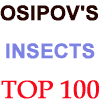 | 
Show appreciation for this site by clicking on flashing butterfly to the left.
The link will take you to a page with links to many insect sites. |

















